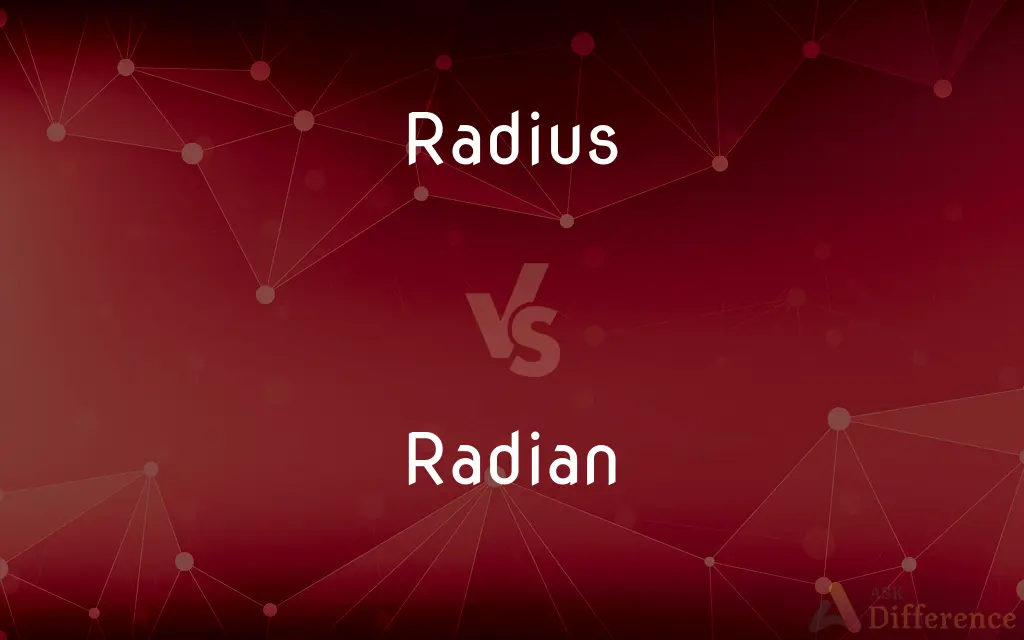Radius vs. Radian — What's the Difference?
Edited by Tayyaba Rehman — By Maham Liaqat — Updated on March 28, 2024
The radius is a straight line from the center to the circumference of a circle, while a radian measures the angle created by taking the radius and wrapping it along the circle's edge.

Difference Between Radius and Radian
Table of Contents
ADVERTISEMENT
Key Differences
The radius of a circle or sphere is a line segment extending from its center to its perimeter or surface, essential in calculating area and volume. A radian, on the other hand, is a unit of angular measurement used in mathematics, particularly in trigonometry and calculus, equivalent to the angle made at the center of a circle by an arc whose length is equal to the radius of the circle.
Radius plays a crucial role in geometric formulas, determining the size and area of circles and spheres, whereas radians are pivotal in measuring angles and in the analysis of periodic functions, like waves.
The concept of radius is straightforward, involving linear measurement, whereas a radian requires understanding the relationship between the length of an arc and the angle it subtends at the center of a circle.
In practical applications, the radius is often used in design and construction to define curves and circular objects. Radians, however, are used in calculus, physics, and engineering for analyzing rotational motion and waveforms.
While the radius is a measure of length, a radian measures angles, making radians dimensionless and expressing the ratio between two lengths—the arc length and the radius.
ADVERTISEMENT
Comparison Chart
Definition
Distance from the center to the edge of a circle.
Angle subtended by an arc equal in length to the radius.
Unit Type
Length
Angular measurement
Use in Geometry
Calculating area, circumference, and volume of circles and spheres.
Measuring angles, particularly in trigonometry and calculus.
Measurement
Linear
Dimensionless (ratio)
Practical Application
Design, construction, and everyday measurements of circles and spheres.
Physics, engineering, and mathematical analysis of rotation and periodic functions.
Compare with Definitions
Radius
A line segment from the center of a circle to its perimeter.
The radius of a wheel determines how far it travels with each rotation.
Radian
The angle made by taking the radius and wrapping it along the circle's edge.
A complete circle is 2π radians.
Radius
The distance from the center to any point on the edge in a circular object.
Knowing the radius helps in calculating the area of the circle.
Radian
A measure used in angular measurements, especially in trigonometry and physics.
Angular velocity is often expressed in radians per second.
Radius
Used to define spheres in three dimensions.
Earth's radius varies depending on the measurement from the center to sea level at different points.
Radian
Unit of angular measure where the arc length equals the radius.
One radian is approximately 57.2958 degrees.
Radius
Essential for calculating the circumference and area of circles.
The circumference of a circle is twice π times the radius.
Radian
Essential in the study of periodic functions such as waves and oscillations.
The frequency of a sine wave can be described in radians.
Radius
A measure of length in linear geometry.
The radius of a sphere is half its diameter.
Radian
Used in calculus to integrate and differentiate angle-based functions.
The derivative of sin(x) is cos(x) when x is measured in radians.
Radius
The length of any such line segment.
Radian
The unit of plane angle adopted under the Systeme International d'Unites; equal to the angle at the center of a circle subtended by an arc equal in length to the radius (approximately 57.295 degrees)
Radius
In classical geometry, a radius of a circle or sphere is any of the line segments from its center to its perimeter, and in more modern usage, it is also their length. The name comes from the Latin radius, meaning ray but also the spoke of a chariot wheel.
Radian
The radian, denoted by the symbol rad {\displaystyle {\text{rad}}} , is the SI unit for measuring angles, and is the standard unit of angular measure used in many areas of mathematics. The unit was formerly an SI supplementary unit (before that category was abolished in 1995) and the radian is now an SI derived unit.
Radius
A line segment that joins the center of a circle with any point on its circumference.
Radian
A unit of angular measure equal to the angle subtended at the center of a circle by an arc equal in length to the radius of the circle, approximately 57°17′44.6".
Radius
A line segment that joins the center of a sphere with any point on its surface.
Radian
(geometry) In the International System of Units, the derived unit of plane angular measure of angle equal to the angle subtended at the centre of a circle by an arc of its circumference equal in length to the radius of the circle. Symbol: rad
Radius
A line segment that joins the center of a regular polygon with any of its vertices.
Radian
An arc of a circle which is equal to the radius, or the angle measured by such an arc.
Radius
A circular area measured by a given radius
Every family within a radius of 25 miles of the city center.
Radius
A bounded range of effective activity or influence
The operating radius of a helicopter.
Radius
A radial part or structure, such as a mechanically pivoted arm or the spoke of a wheel.
Radius
A long, prismatic, slightly curved bone in humans, the shorter and thicker of the two forearm bones, located on the lateral side of the ulna.
Radius
A similar bone in many other vertebrates.
Radius
(anatomy) The long bone in the forearm, on the side of the thumb.
Radius
(zoology) The lighter bone (or fused portion of bone) in the forelimb of an animal.
Radius
(entomology) One of the major veins of the insect wing, between the subcosta and the media; the vein running along the costal edge of the discal cell.
Radius
(geometry) A line segment between any point of a circle or sphere and its center.
Fatima claims to have visited all the bars within a five-mile radius of her Manhattan apartment.
Radius
(geometry) The length of this line segment.
Radius
A right line drawn or extending from the center of a circle to the periphery; the semidiameter of a circle or sphere.
Radius
The preaxial bone of the forearm, or brachium, corresponding to the tibia of the hind limb. See Illust. of Artiodactyla.
Radius
A ray, or outer floret, of the capitulum of such plants as the sunflower and the daisy. See Ray, 2.
Radius
The length of a line segment between the center and circumference of a circle or sphere
Radius
A straight line from the center to the perimeter of a circle (or from the center to the surface of a sphere)
Radius
A circular region whose area is indicated by the length of its radius;
They located it within a radius of 2 miles
Radius
The outer and slightly shorter of the two bones of the human forearm
Radius
Support consisting of a radial member of a wheel joining the hub to the rim
Common Curiosities
How is the radius used in mathematics?
In mathematics, the radius is used to calculate the area, circumference, and volume of circles and spheres.
Why are radians important in trigonometry?
Radians provide a natural way to measure angles in trigonometry, facilitating the analysis and solution of problems involving periodic functions.
What is a radius?
A radius is a line segment from the center of a circle or sphere to its perimeter or surface.
How do radians relate to degrees?
One radian is approximately 57.2958 degrees; there are 2π radians (about 360 degrees) in a full circle.
What is a radian?
A radian is a unit of measure for angles defined as the angle subtended by an arc of a circle with the same length as the radius of the circle.
Can the radius of a circle change?
The radius of a specific circle is constant, but different circles can have different radii.
Is the concept of radius applicable to shapes other than circles?
Primarily, the radius is associated with circles and spheres, though it can conceptually extend to describe the core characteristic of radial symmetry.
What is the practical use of measuring angles in radians?
Measuring angles in radians simplifies the mathematical analysis in physics, engineering, and calculus, especially for rotational motion and wave functions.
How does understanding the radius help in real life?
Knowing the radius of circular objects helps in various practical tasks, like designing and constructing items or determining distances and areas.
How many radians are in a circle?
There are 2π radians in a complete circle.
What is the relationship between radius and diameter?
The diameter of a circle is twice the radius.
Can radians be negative?
Yes, radians can be negative, indicating direction of rotation or position in a cycle, especially in mathematics and physics.
How do you convert from radians to degrees?
To convert from radians to degrees, multiply the radians by 180/π.
Are radians only used in mathematics and physics?
While primarily used in mathematics, physics, and engineering, radians also have applications in computer science and other fields requiring precise angular measurements.
Why might someone prefer using radians over degrees?
Radians make many mathematical formulas simpler and more intuitive, particularly in calculus and when dealing with periodic functions.
Share Your Discovery

Previous Comparison
Ameer vs. Amir
Next Comparison
Wiggly vs. NigglyAuthor Spotlight
Written by
Maham LiaqatEdited by
Tayyaba RehmanTayyaba Rehman is a distinguished writer, currently serving as a primary contributor to askdifference.com. As a researcher in semantics and etymology, Tayyaba's passion for the complexity of languages and their distinctions has found a perfect home on the platform. Tayyaba delves into the intricacies of language, distinguishing between commonly confused words and phrases, thereby providing clarity for readers worldwide.














































